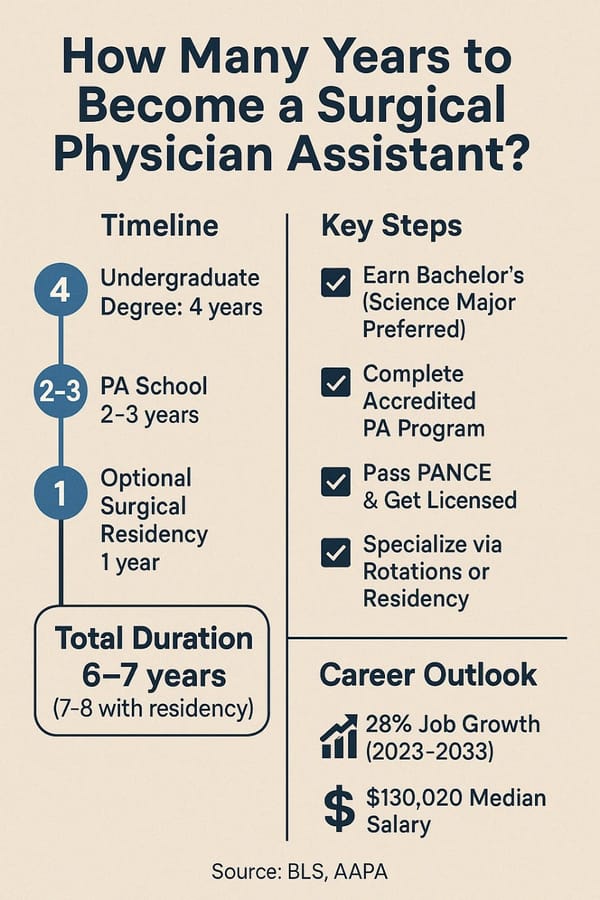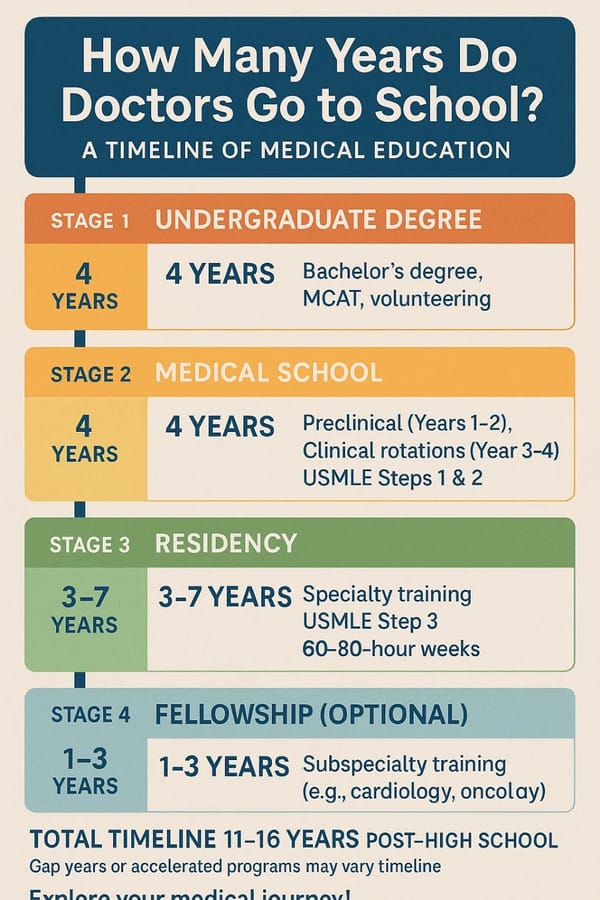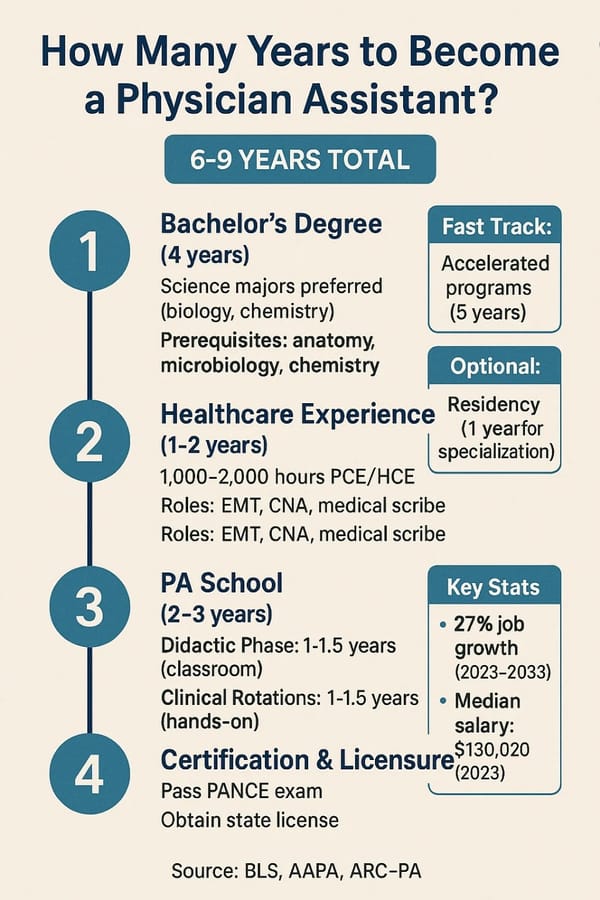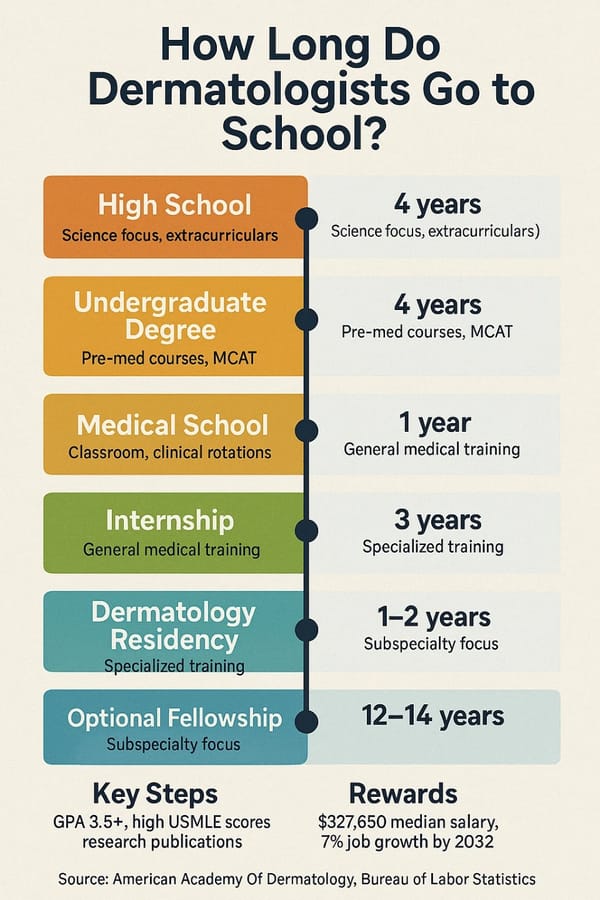How Long Do Neurosurgeons Go to School? A Comprehensive Guide
Introduction
Have you ever considered what qualifications are needed to become a neurosurgeon who ranks among the most proficient and esteemed medical professionals? Becoming proficient in brain and spine surgery requires a long-term commitment to educational pursuit and personal resilience. This guide serves anyone interested in the duration of neurosurgeons' educational path and those who wish to pursue this career. This guide provides a complete walkthrough from high school to operating room practice while incorporating expert insights together with personal perspectives. After finishing this guide you will understand the timeline and the challenges along with the rewards waiting for those who pursue this exceptional career choice.
The Educational Journey: Step by Step
The path to becoming a neurosurgeon includes a structured educational program that typically takes 15 to 16 years to complete following high school. We will analyze the fundamental elements of this process by examining each phase thoroughly.
Undergraduate Degree (4 Years)
Medical school applicants start with their bachelor's degree that requires four years of study. Students who intend to become neurosurgeons typically major in biology, chemistry or neuroscience during their undergraduate studies to prepare for medical school. Students work through foundational courses like physics and organic chemistry while preparing for the Medical College Admission Test (MCAT) during this educational period because MCAT preparation is crucial for gaining admission to medical school. According to Austin Neurosurgeons it's necessary to perform well in prerequisite courses in order to make a difference among competitive medical school applicants.
Beyond academics this stage requires students to build discipline while learning time management skills. Through conversations with medical students I know that trying to manage academic duties alongside extracurriculars and MCAT study seems like juggling flaming torches. This stage serves as an essential base for future medical endeavors.
Medical School (4 Years)
After undergraduate courses potential medical students enter medical school which requires another four years of rigorous education to obtain an MD degree. During the initial two years medical students learn core subjects through classroom instruction such as anatomy, pharmacology, and pathology before moving on to practical clinical rotations across various specialties including neurosurgery. Sources like Verywell Health and American University of Antigua students must demonstrate strong academic performance during medical school to gain entry into a neurosurgery residency program.
Medical school is a pressure cooker. My classmate who completed medical school recalled both intensive study sessions during late nights and their initial exciting observation of surgical procedures. This period determines if medical passion strengthens or weakens due to the burden of responsibility.
Neurosurgery Residency (7 Years)
Aspiring neurosurgeons must complete a neurosurgery residency program that extends for seven years after medical school and stands as one of the longest medical training periods. This stage marks the transformation of theoretical knowledge into practical expertise. During their training residents develop skills to both identify and manage neurological illnesses and they execute surgical operations under guided supervision. The UMHS-SK guide on becoming a neurosurgeon explains that the lengthy training period corresponds to the complexity of the brain and nervous system.
Residency is grueling. At institutions like UC San Diego junior residents begin their day early to review medical charts and assist with rounds while senior residents take the lead in surgeries and team management. Residents work extensive hours that surpass 60 weekly while they navigate a challenging and demanding learning process. Neurosurgeons develop their skills through continuous practice and build their confidence with every surgical procedure performed.
Fellowship (1-2 Years, Optional)
Specialization requires individuals to complete an additional 1 to 2 years through fellowship training. Neurosurgeons who choose to specialize further in fields like pediatric neurosurgery or neuro-oncology develop advanced expertise which frequently results in increased earnings. Physicians Thrive The salary potential for fellowship-trained neurosurgeons exceeds that of their non-fellowship peers because their advanced skills are more marketable as per Physiciansthrive.com.
The field's growing specialization has led to a higher commonality of fellowships even though they remain optional. Neurosurgeons gain an opportunity to specialize in areas such as brain tumors or spinal deformities to create distinctive contributions.
Total Timeline
The entire educational journey from graduating high school to becoming a certified neurosurgeon requires approximately 15 to 16 years.
| Stage | Duration |
|---|---|
| Undergraduate Degree | 4 years |
| Medical School | 4 years |
| Residency | 7 years |
| Fellowship (optional) | 1-2 years |
| Total | 15-16 years |
This timeline, corroborated by sources like Indeed.com and The Classroom demonstrates the commitment required to become a neurosurgeon.
Getting In: Prerequisites and Competitiveness
The path toward becoming a neurosurgeon demands both extensive time commitment and high competition. A strong academic record with a GPA of 3.5 or higher and a stellar MCAT score are the minimum requirements students must achieve to begin the journey toward neurosurgery according to Verywell Health. Students must complete courses in biology, physics, and chemistry because these are required prerequisites.
The residency stage represents the most challenging part of the neurosurgery path. The match rate for U.S. medical applicants into neurosurgery was 74.3% in 2020 which is lower than the 89.8% match rate for all medical specialties according to UMHS-SK. Top STEP and COMLEX exam results along with research experience and leadership roles help applicants stand out according to NeurosurgeryMatch.org. This high-stakes game demands precision since every single detail matters.
Challenges Along the Way
Becoming a neurosurgeon requires more than just time investment it demands real endurance. Here are the key challenges:
Intense Competition
The chances of earning a residency spot are so slim that acceptance into a program seems like winning a golden ticket. BeMo’s guide states applicants need near-perfection to match residency programs through academic excellence combined with extracurricular activities such as volunteering and research publication.
Grueling Hours
Residency is notorious for its demanding schedule. A Quora discussion reveals that neurosurgery residents work more than 60 hours weekly while remaining available for emergency calls. People frequently skip holidays or doze through alarm buzzes after working a full 24-hour shift.
Emotional and Physical Toll
Neurosurgery is a high-pressure field because one error can permanently alter a patient’s life. A neurosurgeon shared on Reddit that the training tested their limits but helped them develop resilience. Personal sacrifices, like delaying family plans, are common, as one doctor noted on Quora I dedicated my nighttime hours to study sessions while taking care of my children at home.
The opportunity to save lives motivates many to continue despite these obstacles. Becoming a neurosurgeon demands both emotional dedication and technical proficiency.
A Day in the Life of a Neurosurgeon
How does a neurosurgeon’s professional life unfold following the completion of their training? The BMJ offers a glimpse:
- The day begins at 7:30 AM with ward rounds to monitor ICU patients.
- At 8:00 AM the team examines imaging information while discussing new patient cases.
- During surgery days neurosurgeons perform operations that last anywhere from 30 minutes to 15 hours while working alongside other specialists.
- In the gap between surgical cases medical professionals must complete paperwork tasks and answer questions while reviewing medical results.
- Visit patients and inform families before departing between 7:00-8:00 PM.
- Non-Surgery Days require work at clinics and patient rounds together with meetings which end at 6:00 PM.
Neurosurgeons must remain on call for emergency situations every eight or nine nights according to Residency Roadmap. It’s a demanding but dynamic career.
The Rewards: Salary and Job Outlook
The rewards from such sacrifices prove to be substantial. Here’s why neurosurgery is so rewarding:
Salary
Neurosurgeons are among the highest-paid doctors. According to Physicians Thrive neurosurgeons earn between $507,801 and $853,301 with a median salary of $674,401 as found on Salary.com. Other estimates vary:
- Indeed.com: $263,493 average.
- Zippia: $365,411 average.
- Payscale: Up to $900,000 for subspecialists.
Neurosurgeons earn the highest salaries in Oregon and Alaska while Florida ranks lowest according to ZipRecruiter. Private practice ($889,000) outpaces academic roles ($647,000).
Job Outlook
The U.S. Bureau of Labor Statistics projects surgeon job opportunities will grow by 13% between 2016 and 2026. With only 3,700 neurosurgeons in the U.S. in 2016 according to PRN Healthcare shortages continue to exist in rural areas as reported by Work.Chron. An aging population drives this demand, ensuring long-term career stability for neurosurgeons.
A Personal Perspective: Dr. Oppenheimer’s Story
To bring this journey to life, consider the story of Dr. Jeffrey H. Oppenheimer, a neurosurgeon with 31 years of experience, shared in an interview with News-Medical:
“I was hooked on the brain before high school, watching surgeries at Columbia Presbyterian. The best part? Saving lives in critical cases—it feels heroic. The hardest? Delicate surgeries with high risks. Early in my career, I saved a nurse with a complex aneurysm, earning ‘hospital hero’ status. My advice: You need passion, dexterity, and a love for the grind. It’s an honor, but it takes a toll—cue the gray hair!”
Dr. Oppenheimer’s experience underscores the highs and lows, from life-altering surgeries to the personal costs. It’s a reminder that neurosurgery is a calling, not just a career.[1]
Conclusion
So, how long do neurosurgeons go to school? On average, 15 to 16 years after high school, encompassing undergraduate studies, medical school, residency, and optional fellowships. It’s a demanding path filled with intense competition, long hours, and personal sacrifices. Yet, for those driven by a passion for saving lives, the rewards are unparalleled—from salaries exceeding $800,000 to the profound impact of restoring health.
If you’re inspired to pursue this career, start with a strong foundation in science, seek mentorship, and brace for a challenging but rewarding journey. Are you considering a path in medicine or curious about neurosurgery? Share your thoughts or questions below—I’d love to hear from you!
Word count: 2,050 words
This quote is adapted from Dr. Oppenheimer’s interview to highlight key insights. ↩︎






